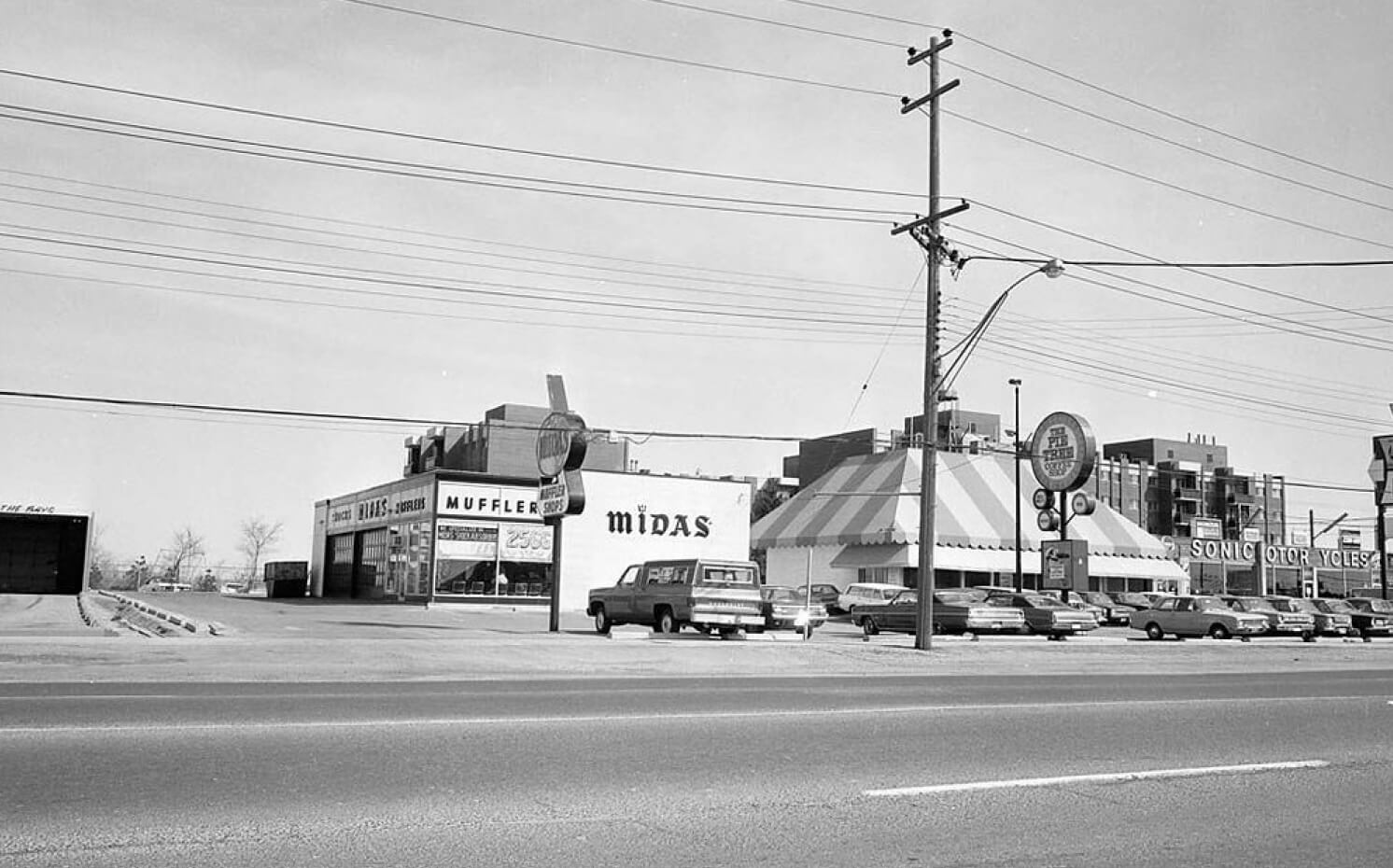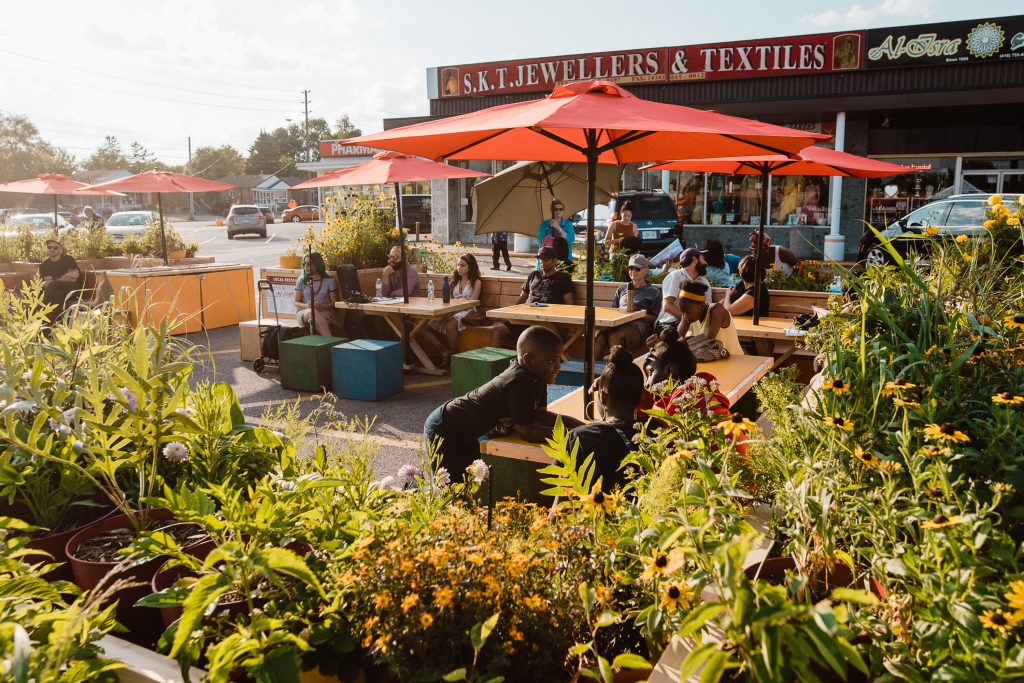

What we do
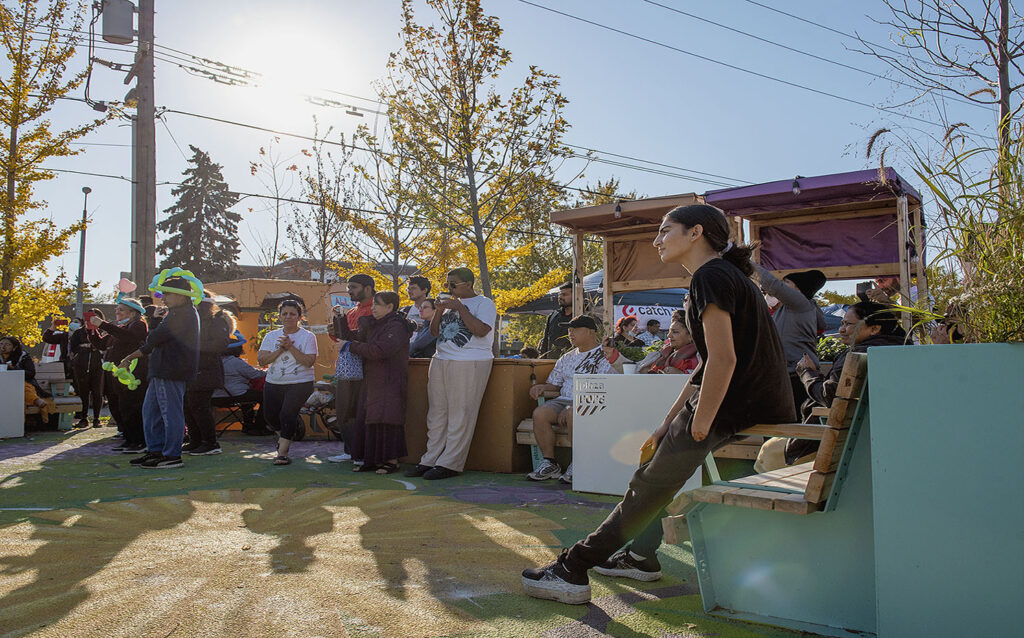
plazaPOPS is a collaborative approach to transforming privately-owned parking lots and underinvested spaces into accessible gathering places to support thriving culture, community health, and small businesses.
People
Working in different neighbourhoods, plazaPOPS facilitates a community design process with local residents, community organizations, and business owners to create temporary “pop-up” installations designed for the unique conditions of the city beyond the downtown core.
Place
plazaPOPS invites the public to spend time in parking lots and underused spaces – that are often privately owned – the way they might in a traditional public space: to linger and people watch, to smell the flowers and admire a butterfly, to meet a friend for a coffee or take in a programmed event, or to rest comfortably for a few minutes, while waiting for the bus. There is no cost to enter and everyone is welcome.
Impact
Through our research initiative, plazaPOPS measures the social, economic, and environmental impacts of our projects, while documenting our approach to inspire and enable other organizations to transform underused spaces in their communities into dynamic gathering spaces that support the local economy.
How it started
plazaPOPS recognizes and deeply values the work of the writers, researchers, activists, artists, and city builders who have been working tirelessly on inner suburban equity for many years before our organization was established. We acknowledge that their contributions have laid the foundation for the work we do today, and without their efforts, we would not be where we are now.
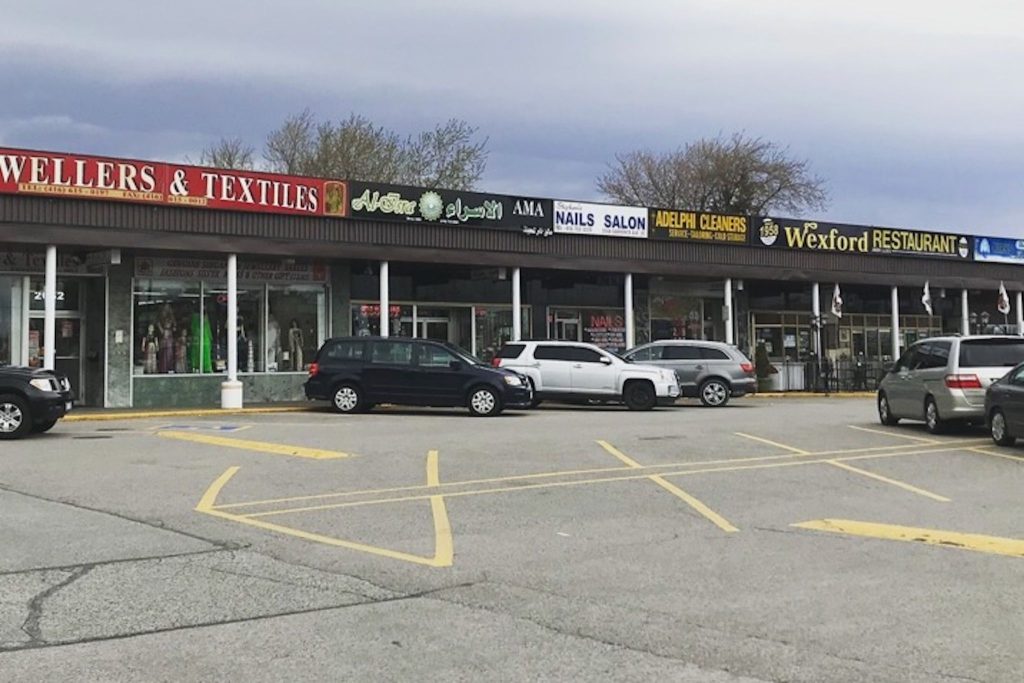
plazaPOPS grew out of co-founders’ Brendan Stewart and Daniel Rotsztain’s dedication to co-design and celebrating Toronto’s inner suburbs. Brendan Advised Daniel’s University of Guelph Masters of Landscape Architecture thesis along with Dr. Karen Landman.
The thesis interviewed strip mall owners, business owners and patrons about their vision for enhancing strip malls, and found that strip mall users desired an improved landscape, especially adjacent to restaurants and cafes. Identifying a lack of appropriate streetscape enhancement programs within the City of Toronto, Daniel’s thesis concluded that a new program needed to be created to test the ability for low-cost, high impact public space enhancement projects on privately-owned but publicly used strip mall parking lots.
Daniel’s thesis was completed as Park People announced their Public Space Incubator grant – an initiative funded by Ken and Eti Greenberg and the Balsam Foundation to support innovative public space initiatives in a growing and dynamic city. Daniel, Brendan and Karen teamed up with the Wexford Heights BIA and Scarborough Arts to put together an application to pilot plazaPOPS. They received the grant in August 2018, along with additional funding from the City of Toronto‘s BIA Innovation fund.
WexPOPS, the pilot plazaPOPS popped up in July 2019 alongside the Wexford Heights BIA’s annual Taste of Lawrence festival. The installation occupied 10 parking spots at the Wexford Plaza. Throughout the installation, the site was programmed by events, concerts and other community initiatives. See more about WexPOPS here.
After the success of WexPOPS, plazaPOPS and the University of Guelph partnered with the City of Toronto in a SSHRC-funded research project exploring the “why”, “where”, and “how” of a sustainable, city-wide plazaPOPS program. plazaPOPS strengthened their relationship with the City of Toronto as a core partner, hosting a round table of representatives from multiple city divisions as part of the research.
In 2021, plazaPOPS received operational funding for 3-years from the Federal Development Agency for Southern Ontario, through its “Main Street Renewal and Rebuild” Initiative, and the organization continues to expand in exciting ways!
Why we do it
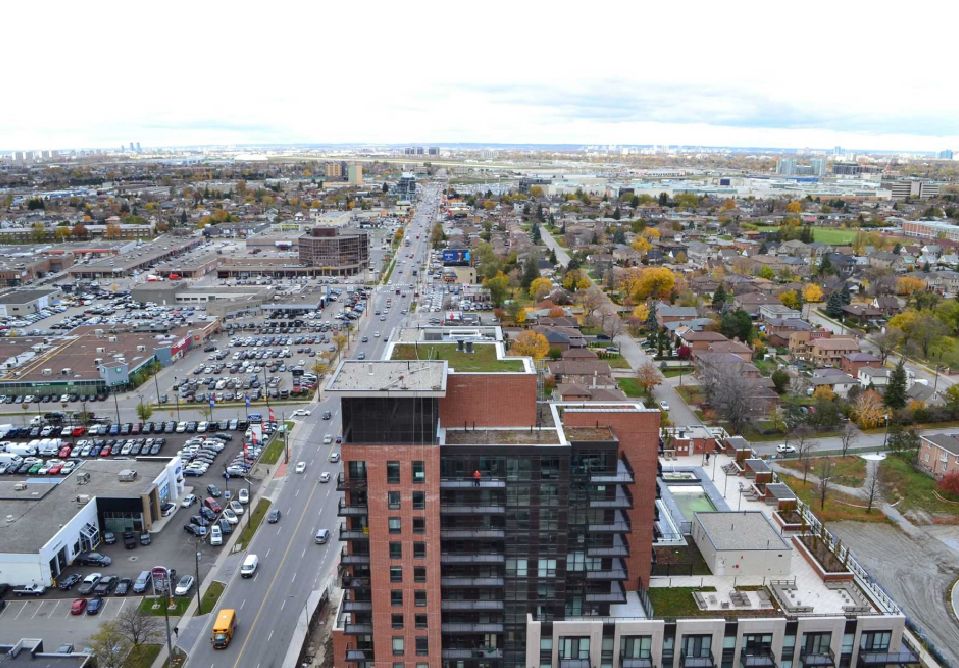
Built for the scale of the car, Toronto’s strip mall main streets are equipped with little infrastructure to support their increasing pedestrian usage. This disparity of design is an issue of social justice; as rents in Toronto’s walkable old city and along its transit lines increase, low income residents who are dependent on walking and public transportation are concentrating in the service-deficient, automobile-scale inner suburbs, where rents are more affordable.
While the deficiency of pedestrian amenities such as seating, shade and crosswalks contributes to a lack of dignity for pedestrians navigating the inner suburbs, its worst consequence is the rise of pedestrian deaths in areas designed with the sole purpose of accommodating high-speed vehicular traffic.
As the site of local and independent retail, strip malls play a central role in the public life of inner suburban communities. Due to their ubiquity and high visibility, demonstrating strip malls’ capacity to accommodate pedestrian amenities could have a profound effect on how we conceptualize Toronto’s inner suburban arterials. Rather than wide roadways intended to move cars as fast as possible, enhancing strip mall landscapes for pedestrians would affirm their role as the main streets of Toronto’s inner suburbs, boasting their own version of suburban-style pedestrian urbanity.
Supporting strip malls with landscape enhancements also contributes to the growing discourse highlighting their value as the most affordable commercial spaces for low-income and new immigrant communities. While additional investment and attention might contribute to increased rent at strip malls, strategies to protect commercial affordability must be formulated before accessible commercial spaces are replaced.
As Toronto directs growth to its inner suburban ‘Avenues’, strip malls are being demolished and replaced by high-density, mixed-use structures that lack affordable spaces for the businesses they are replacing. Enhancing the public realm adjacent to strip malls is essential to recognize and support existing affordable spaces, weaving them into the imagination of Toronto’s public life, and anchoring the inevitable densification of the inner suburbs.
The big idea is to create a form of social infrastructure and local economic development that is tailored to the conditions of the suburbs, where the need for public realm enhancement is often great, but difficult to achieve due to the limited amount of land in public ownership. plazaPOPS is demonstrating the positive impacts of a new type of community gathering space that creates multiple benefits for the local community, and the business and property-owners who host the installations. plazaPOPS explores concepts of access by inviting more uses into typically less-accessible, privately-owned space, and within the installation itself, setting the stage for greater access to ourselves and to each other.
Where it happens
plazaPOPS happen wherever a community of business owners and local organizations come together to activate underused spaces like strip mall parking lots.
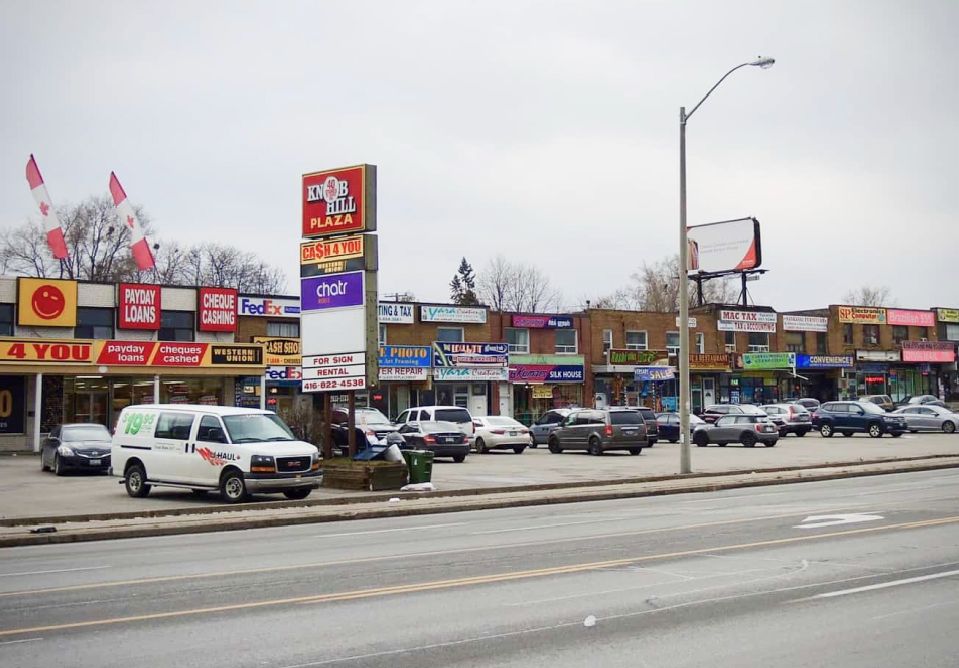
Toronto’s iconic strip mall main streets were designed to accommodate the automobile, strip malls and the neighbourhoods surrounding them are increasingly home to low-income and new immigrant populations who have low rates of car ownership. With affordable rents, strip malls within walking and transit distance of these communities have become vibrant gathering third places.
plazaPOPS is inspired by the rich vitality of community life that exists inside the walls of the inner suburban strip-mall, and motivated to allow this existing urbanity a chance to spread beyond the buildings and to linger beyond business hours. To give the various communities in the neighbourhood, whose paths may not otherwise cross, a chance to meet and get to know each other under the sky, and amongst the plants. In this way, plazaPOPS tries to enhance the ‘urban’ already in the suburban.
Most POPS (privately-owned public spaces) are permanent, built by developers on private property and negotiated as a public benefit through the planning approvals process—think of a publicly accessible parkette at a street corner on the site of a new condominium building. plazaPOPS are also on private property, but they are community initiated and temporary, popping up during the warmer months. They are imagined as a short- to medium-term strategy, enhancing the public realm today with the goal of informing the longer-term evolution of the neighbourhood, as densification continues.
When it happens
plazaPOPS are temporary, “pop-up” installations that are typically active between May and November.
But the activity doesn’t start or stop there! We are always working on building relationships with community partners, organizations, government, and planning the community design process for our future installations.
How we do it
plazaPOPS installations are created through partnerships with local land and business owners, arts & culture organizations, community service providers, and municipal agencies.
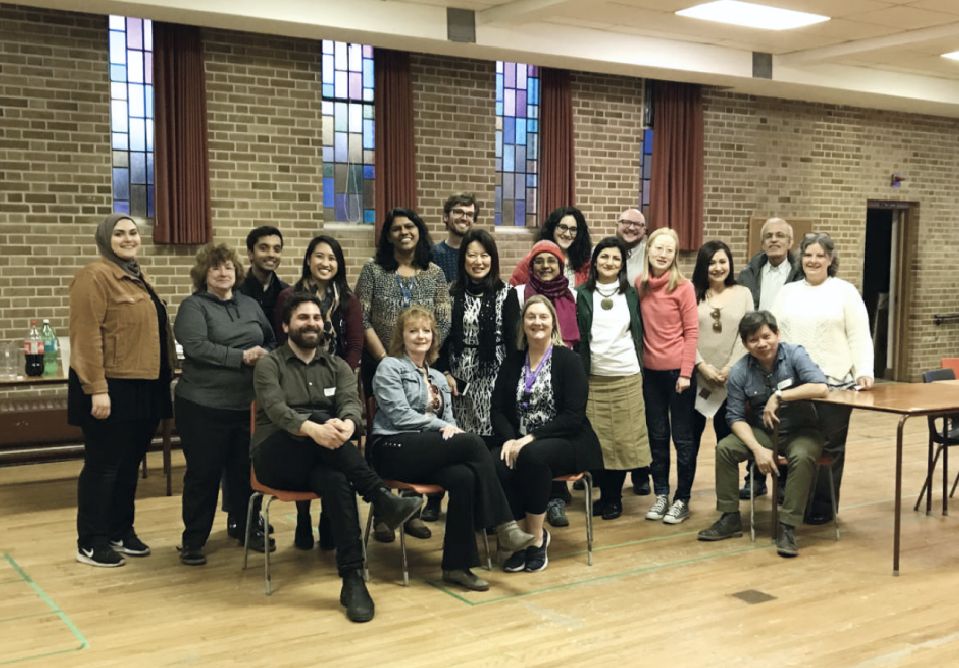
A diverse working group composed of local community leaders is established and designs are generated through a collaborative process that is deeply rooted in place, reflecting local culture, encouraging local stewardship, and creating a legacy of stronger networks in our host communities. Research is embedded in our process: impacts are evaluated, and the model is refined and shared.
Who does it with us
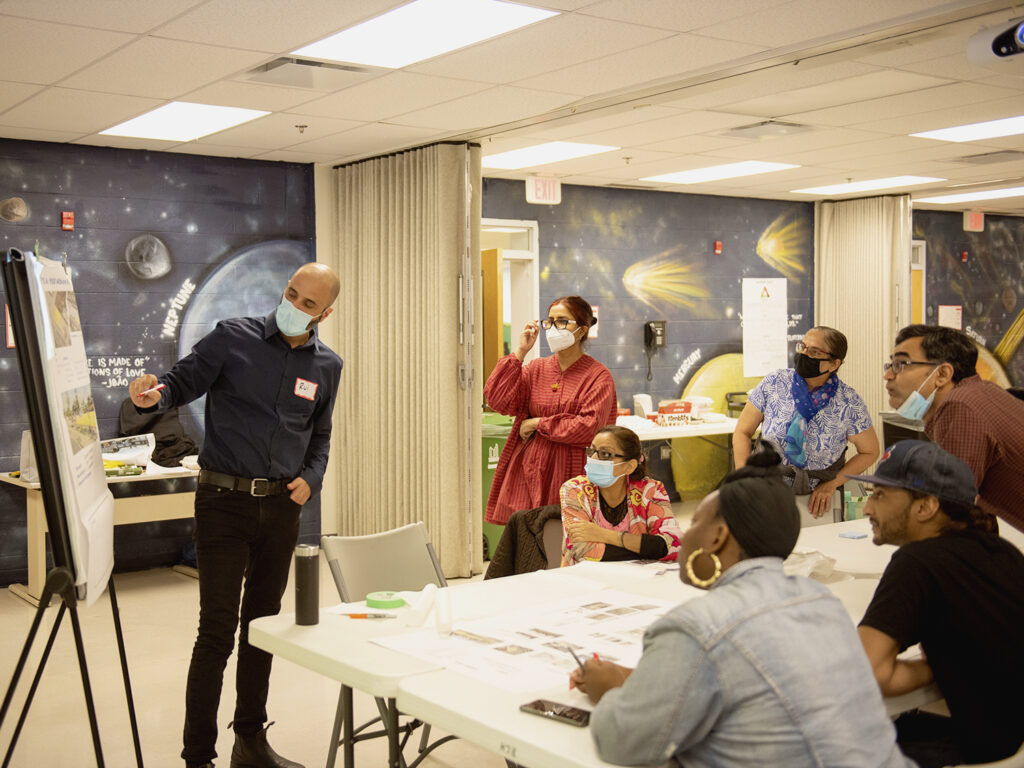
Transforming parking lots and underused spaces into community gathering places takes many partnerships!
As a collaborative initiative, plazaPOPS facilitates design, installation, programming, and research with partners across many sectors.
Community Organizations
For each of its projects, plazaPOPS collaborates with a Local Anchor Partner, typically a community organization deeply embedded in the social fabric of a neighbourhood.
Local Businesses
Business Improvement Areas (BIAs) are an important platform for enhancing the public realm of commercial districts, and plazaPOPS is being developed as a suburban BIA tool, although we also envision these installations popping up in non-BIA commercial districts, too. Responsive to the shape and structure of the suburban main street and its public realm defined by privately owned parking lots, the idea hinges on the proposition that commercial landowners and the local business community will see enough value to offer a few parking spaces and participate in a community-oriented, city-building project.
Municipalities
plazaPOPS works closely with municipalities to fund, implement, and research its initiatives. The City of Toronto has partnered with plazaPOPS since its 2019 pilot. Working closely with the City of Toronto has helped us understand the “why”, “where” and “how” of a scaled out, citywide initiative. The City has supported plazaPOPS in its negotiation of municipal bylaws and permitting,
Through this foundation of partnership, the initiative invites traditional public space uses into an often-hostile pedestrian landscape. Under the dynamic lights of strip-mall signage, adjacent to the smells and sounds of a truly international assortment of restaurants and shops, and surrounded by cars, plazaPOPS invites the community to linger and meet itself.
